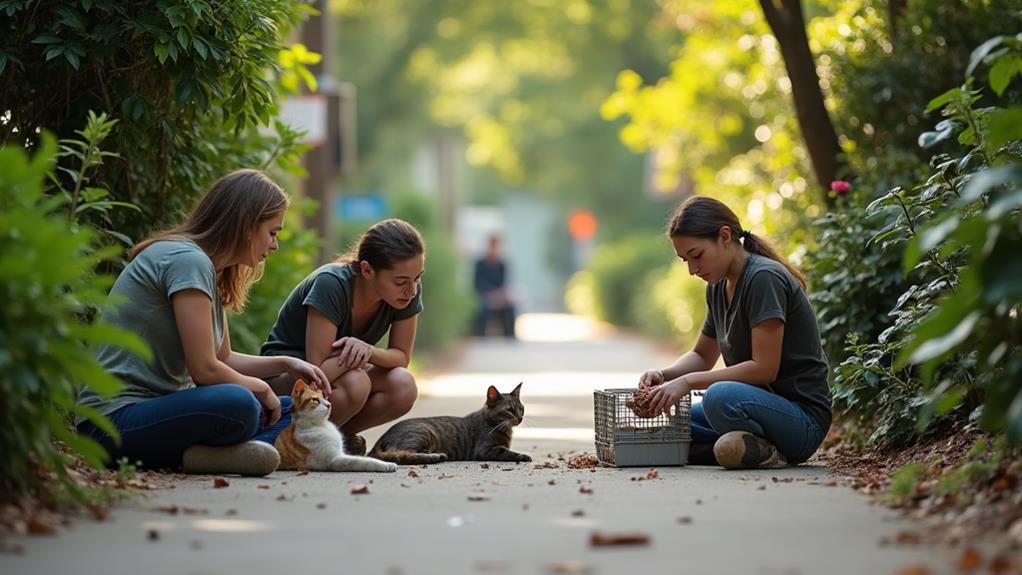How to Control the Feral Cat Population: Humane Methods for TNR

To control feral cat populations humanely, adopt the Trap-Neuter-Return (TNR) approach. This method involves trapping, neutering, and returning cats to their habitats, curbing population growth by preventing new births. It's supported by the public for promoting healthier feral cat colonies and reducing shelter intakes. Engage your community to participate in TNR efforts, aiding in trapping, feeding, and monitoring. Vaccinations during TNR help prevent diseases like rabies. Over time, communities experience fewer nuisance behaviors and healthier ecosystems. Tackling challenges like funding and legal support can improve TNR efforts. Investigate further to see how TNR integrates into broader community care strategies.
Understanding Trap-Neuter-Return
Trap-Neuter-Return (TNR) is a proven, humane strategy for managing feral cat populations by focusing on three essential steps: trapping, neutering or spaying, and returning. You might wonder why this approach is effective. Well, TNR directly addresses the root cause of feral cat population growth—reproduction. By spaying and neutering community cats, you can control and stabilize managed colonies, preventing new births and thereby reducing the feral cat numbers over time.
The benefits extend beyond mere population control. Neutered and spayed cats enjoy improved health and well-being, as they're less prone to diseases and aggressive behaviors often associated with mating. Healthier cats mean fewer cat-related calls to animal control and a decreased intake of feral cats in shelters, demonstrating TNR's effectiveness.
Moreover, TNR plays an essential role in shaping public perception. As over 80% of Americans support the humane treatment of community cats, TNR aligns with these values, offering a compassionate alternative to euthanasia. This method fosters a more harmonious coexistence between humans and feral cats, enhancing community relations and promoting an understanding of humane wildlife management. Through TNR, you contribute to a sustainable, ethical solution for feral cat populations.
Benefits of TNR Programs
Among the numerous benefits of TNR programs, the most significant is their ability to drastically reduce feral cat populations. Studies, like those from the University of Florida, show decreases of up to 66% over 11 years. By addressing the root cause of feral cat overpopulation, TNR programs prove to be more effective than traditional animal control methods. Neutering improves the overall well-being of these cats, as it cuts down mating behaviors and lowers disease susceptibility, allowing them to lead healthier, stress-free lives.
Another advantage is the cost-effectiveness of TNR. With fewer cats entering shelters, communities save on resources that would otherwise be spent on intake and euthanasia. This reduction in shelter intake decreases the burden on already overstretched facilities, making it a smart economic choice.
Moreover, TNR's humane approach connects well with the public. Over 80% of Americans favor leaving cats outdoors rather than euthanasia, showing strong public support for TNR initiatives. This backing highlights the community's preference for compassionate, sustainable solutions over more drastic animal control methods. By choosing TNR, you contribute to a balanced approach that benefits both feral cats and the communities they inhabit.
Community Involvement in TNR

Engaging the community is paramount for the success of TNR programs. You play a significant role in managing feral cat populations. Community involvement means that local volunteers, like yourself, actively participate in trapping, feeding, and monitoring cat colonies, guaranteeing humane treatment. It's heartening to know that over 80% of Americans support TNR over euthanasia, showing a collective willingness to care for these animals.
Educational initiatives are key. By spreading information about TNR's benefits, you can foster greater public support and understanding. These efforts help people see how humane treatment and management of feral cats can positively impact the neighborhood. Working with local animal welfare organizations and veterinary clinics is fundamental. They provide resources, training, and access to spay/neuter services, enhancing community involvement and making it easier for you to contribute effectively.
Consistent communication with neighbors is also significant. Addressing concerns and building support guarantees the long-term sustainability of TNR initiatives. By staying informed, volunteering your time, and collaborating with others, you help create a more compassionate and effective approach to managing feral cat communities. Together, you can make a substantial difference in their lives.
TNR's Scientific Foundation
With a solid scientific foundation, TNR programs have proven effective in managing feral cat populations. Research highlights significant reductions, such as a 66% decrease over 11 years in Florida and a 16%-32% decrease in colony size over a decade in Rome. These results demonstrate TNR's impact on population stability, primarily through neutering. Neutering not only prevents new births but also improves the health of cats by reducing disease susceptibility and limiting mating behaviors.
The "vacuum effect" theory backs TNR's effectiveness by showing that removing cats often leads to new ones moving in. In contrast, TNR stabilizes populations, maintaining a controlled number of cats in a given area. This stability is not only a humane method but also cost-effective, as it reduces the number of cats entering shelters, lowers euthanasia rates, and cuts down costs associated with traditional animal control methods.
For TNR to succeed, community education is vital. Public support guarantees ongoing participation and understanding, which are significant for sustainable outcomes. By engaging communities, you help maintain the effectiveness of TNR, contributing to healthier, more stable feral cat populations while addressing concerns humanely and economically.
Overcoming TNR Challenges

To effectively address and overcome the challenges facing TNR programs, it's vital to tackle misconceptions head-on, particularly those surrounding the impact of feral cats on wildlife and public health. These misunderstandings can dampen community support for TNR efforts. You need to focus on community education and outreach efforts to demystify these issues, ensuring people understand that TNR is a humane and effective way of managing feral cat populations.
Funding and resources are another significant hurdle. Limited budgets often restrict the scalability of your TNR initiatives. To sustain these efforts, actively seek grants and build community partnerships. This approach not only provides necessary funding but also strengthens local support for TNR. Legal barriers can also complicate implementation. Engaging with local governments to advocate for humane management policies is vital. By doing so, you can help create a legal framework that supports TNR.
Feral Cat Population Statistics
Understanding the magnitude of the feral cat population is essential to appreciating the challenges TNR programs face. In the U.S., the population of feral cats ranges from 30 to 80 million, while globally, it's between 60 to 100 million. These numbers highlight the feral cat problem and the urgent need for a humane and effective approach. Feral cats contribute considerably to cat overpopulation, with millions entering shelters each year, pushing high euthanasia rates.
In Alachua County, feral cats account for at least 46% of the total cat population. About 12% of households here provide for an average of 3.6 cats living outdoors, often at feeding stations. This makes the formation of TNR colonies around these food sources common. These colonies typically consist of 3 to 10 cats, complicating efforts to manage the population effectively.
Spay and neuter initiatives are vital in addressing the feral cat problem, as they help stabilize and gradually reduce their numbers. The average lifespan of feral cats, ranging from 2 to 5 years due to harsh conditions, underscores the significance of implementing TNR as a humane solution to control their population.
Health Concerns and TNR

When considering TNR programs, it's important to address the health concerns associated with feral cats. Feral cats can carry zoonotic diseases like rabies and toxoplasmosis, which pose risks to humans and domestic animals. Since 1981, rabies cases in cats have surpassed those in dogs, emphasizing the significance of vaccinations. TNR programs often include vaccinations against rabies and other diseases, greatly reducing disease transmission within the colonies and to humans. These humane methods aim to curb the spread of illnesses while controlling the feral cat population.
However, health monitoring is essential in these programs. A study from Key Largo found that 17% of feral cats were euthanized post-TNR due to untreated health issues, underscoring the need for regular check-ups. Moreover, high mortality rates in managed colonies raise concerns. One study showed that 75% of kittens died or disappeared, highlighting the significance of addressing welfare post-return. Continuous health monitoring and management strategies are crucial to tackle disease transmission risks among feral cats and the surrounding community. By focusing on these health concerns, TNR programs can improve the well-being of feral cats and reduce potential health threats to humans and domestic animals.
Ecological Impact of Cats
While addressing health concerns in TNR programs is significant, the ecological impact of feral cats can't be overlooked. Feral cats are responsible for about 2.4 billion bird deaths annually in the U.S., devastating local bird populations and causing severe ecosystem disruption. These cats don't just affect birds; they also threaten wildlife by preying on vulnerable species and competing with native predators. Such predation particularly impacts endangered species, pushing them closer to extinction.
In urban areas, the presence of feral cats poses a heightened risk to bird populations. Studies reveal they're a leading cause of decline among certain bird species, emphasizing the need for effective management. This is where TNR comes into play. By trapping, neutering, and returning feral cats, you can mitigate their ecological impact while addressing animal welfare concerns.
Moreover, feral cats can trigger mesopredator release, altering the balance of local food webs and further contributing to ecosystem disruption. Understanding these dynamics is essential for anyone involved in TNR efforts. By implementing thoughtful strategies, you help protect wildlife and maintain ecological balance, ensuring that both feral cats and native species can coexist harmoniously.
Managing Feral Colonies Humanely

Managing feral cat colonies humanely is both a responsibility and a challenge for those involved in TNR programs. You play a significant role in balancing population control with the welfare of stray and feral cats. TNR is your go-to strategy, where trapping, neutering, and returning cats to their colonies effectively stabilize their numbers. High neutering rates, between 70% and 94%, are essential. Without thorough trapping, population control efforts might falter, making your task harder.
Vaccination is another key component, guaranteeing that cats are protected against diseases, which is fundamental for both the cats' health and community safety. Engaging with the community is critical. By educating residents on the benefits of TNR, you foster support for humane management practices, addressing common concerns about feral cats.
Ongoing monitoring and data collection are important. By keeping track of feral cat colonies, you assess the success of TNR efforts and adapt strategies as needed. This collaboration with public health officials guarantees that both animal and community welfare are prioritized. Through TNR, you're humanely managing feral cat colonies, reducing their numbers, and bringing about a positive change in your community.
Alternatives to Euthanasia
Euthanasia isn't the only option for managing feral cat populations; Trap-Neuter-Return (TNR) presents a humane and effective alternative. By trapping feral cats, getting them spayed or neutered, and returning them to their original habitats, TNR reduces the number of kittens born each year. This approach not only guarantees significant population reductions but also improves community relations and public support.
Consider these benefits of TNR:
- Population Control: A University of Florida study revealed a 66% decrease in feral cat populations over 11 years with TNR.
- Shelter Intakes: Communities implementing TNR see decreased shelter intakes, as fewer cats are born and brought in.
- Cost-Effectiveness: TNR is more cost-effective than traditional animal control, saving resources for municipalities and shelters.
Public support for TNR is strong, with over 80% of Americans preferring it over euthanasia, highlighting a shift towards humane treatment. This method results in fewer complaints related to feral cats, reflecting improved community relations. In general, TNR presents a compassionate and practical solution for managing feral cat populations, reducing the need for more drastic measures and fostering a better environment for both cats and humans.




